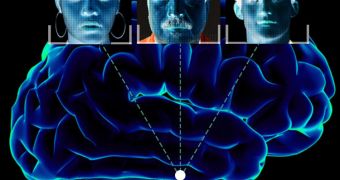A group of investigators at the Massachusetts Institute of Technology (MIT) says that it was recently able to identify which parts of a specific brain area are face-selective. That a region called the fusiform gyrus played a role in this was known for a long time, but which parts of it were involved in the process remained a mystery.
When the role of the fusiform gyrus was established, about 10 years ago, many of its cells were found to play a very important role in helping people recognize the faces of individuals they encountered.
It was discovered that several other parts of the brain were involved in this process as well, and that the fusiform gyrus had to interact and communicate with all of them in order to underlie this human ability.
In the new study, the MIT group was able to keep track of how the connections between various parts of the brain were used during face-recognition. This allows scientists to accurately predict which parts of the fusiform gyrus are involved in face-selection.
Details of the study were published in the December 25 issue of the top journal Nature Neuroscience. The research was made more difficult by the fact that the gyrus has a different structure in every person. As such, its role could only be assessed by analyzing its connectivity patterns.
Investigators used a brain-imaging technique called functional Magnetic Resonance Imaging (fMRI) to conduct the new investigation. “Rather than just mapping the brain, what we’re doing now is adding on to that a description of function with respect to connectivity,” researcher David Osher says.
He was the lead author of the new paper. Osher is a graduate student at MIT, in the lab of the Grover Hermann professor of health sciences and technology and cognitive neuroscience, John Gabrieli. The latter is also a member of the McGovern Institute for Brain Research.
“For every measurable unit of the brain at this level, we have a description of how it connects with every other region, and with what strength it connects with every other region,” Zeynep Saygin says.
The expert, also a lead author of the new paper, is a graduate student at MIT. Gabrieli and associate professor of brain and cognitive sciences Rebecca Saxe are his advisors. Saxe is also the senior author of the research paper.
“This is the first time we’ve had direct evidence of this relationship between function and connectivity, even though you certainly would have assumed that was going to be true,” Saxe explains.
“One thing this paper does is demonstrate that the tools we have are sufficient to see something that we strongly believed had to be there, but that we didn’t know we’d be able to see,” she concludes.

 14 DAY TRIAL //
14 DAY TRIAL //